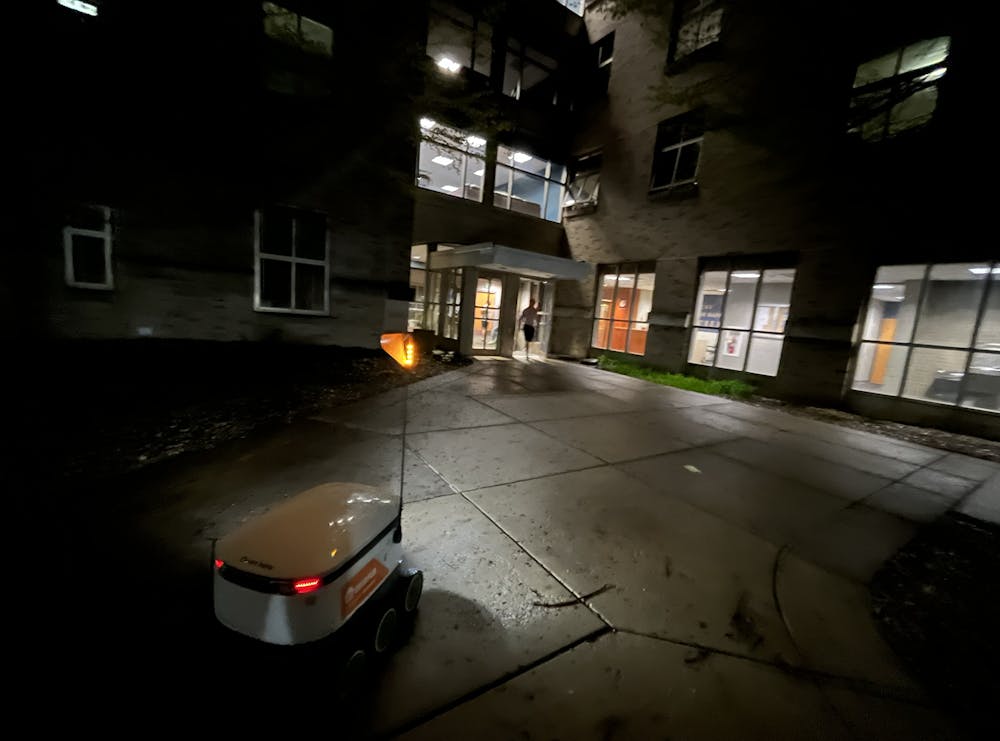Over a year has passed since a fleet of 30 bright orange Grubhub robots suddenly appeared on Notre Dame’s campus. Although dodging their willful, pre-programmed paths and watching them wheels-up in the snow has become commonplace, it is worth reevaluating the impact of these machines on our community.
When the robots first wheeled out on their campaign to conquer campus, proponents of the new scheme heralded the “convenience” that students would now have. No longer would they have to trek to the dining halls or on-campus restaurants, but instead they could have food delivered straight to their door.
The Grubhub machines did not emerge in a vacuum, however. The robots were a “natural progression” from other Grubhub initiatives on campus, including the mobile app and kiosk ordering introduced in 2018, according to Adam Herbert, senior director of campus partnerships at Grubhub.
The Grubhub robots were part of a larger innovation in the way students buy and eat their food on campus. Campus Dining has deemphasized the dining halls by further pushing flashy, name-brand restaurants (or mediocre ones with smaller names) onto students. In the dining hall, kiosks have taken the place of a smile from the burger guy or the omelet woman. We spotted a mobile order $1.49 banana for pickup this week at Hagerty, with a trademark Grubhub slip taped on. With the advent of entirely contact-free restaurants like Gipper’s, we are barreling towards dystopia. Long, sit-down meals are discouraged, with speed being the ultimate goal. Interactions with food service employees are limited, and convenience takes priority over conversation.
Those who proclaim the benefits of the Grubhub robots and ordering system might point to the convenience of being able to pick up food without spending time waiting in line, as well as the ease of choosing between a variety of restaurants.
These marginal benefits have been ordered in advance at a steep cost — leagues more than a bowl from Garbanzo Mediterranean.
For one, we’ve compromised the pedestrian nature of campus. When the University announced its ban on electric scooters in November, it argued “the proliferation of mechanized vehicles on campus is inconsistent with the pedestrian character of campus we have tried to preserve.” By this standard, why should we tolerate mechanized Grubhub robots terrorizing our walkways and not electric scooters?
Secondly, students are pressured into spending money unnecessarily. With the current annual total cost of attendance at Notre Dame exceeding $83,000, students are already spending enough money to be here. Although flex points in dining plans give students the flexibility to eat at on-campus restaurants for no extra charge, students often go through this money quickly, especially with inflated prices at on-campus restaurants. A cheesy bean and rice burrito at Taco Bell is $2.59, more than double the listed price on their website (especially painful when you return to your room and find that after this human-free encounter, it is something other than a cheesy bean and rice burrito).
The dining halls can serve as a great equalizer in the community, giving all students the opportunity to choose from the same set of options without the social pressure to spend money.
Perhaps most importantly, the Grubhub food apparatus encourages isolation amongst students. No longer are students encouraged to congregate with friends in the dining hall, but instead they are programmed to eat as quickly as possible, while talking to as few people as possible.
Having impromptu interactions with one’s peers is an invaluable part of the college experience. Eating a meal is about much more than wolfing down calories before returning to your homework. It’s about setting down the worries of the day for a few moments to spend time with others and appreciate life. As the mural of the Last Supper on the wall of South Dining Hall reminds us, a shared meal is sacred.
Any benefits that the Grubhub kiosks and robots bring are surely marginal. Ordering through GrubHub is not always as efficient as picking up a meal yourself. If students see a long line at a restaurant, they might decide to take their business elsewhere. With no such disincentive in the app, orders pile up, leading to longer wait times.
Even if ordering ahead on Grubhub is occasionally faster and more convenient, the “grab and go” option at the dining hall already exists as an alternative for those in a rush.
Ultimately, the groups which benefit the most from this shift to Grubhub dining are the campus restaurants and Grubhub itself.
The University, in pursuing this system, has sought to create the most profitable experience for its partners and the most convenient system for its students without pausing to question whether it was creating the most fulfilling experience.
Notre Dame is not a hotel. It is not a business. It is a University and a community. Its ultimate goal is and always ought to be the academic, moral and social development of its students. It is long overdue that the University asked themselves if the Grubhub robots and kiosks help further this goal.
Until a change in policy occurs, we encourage students to speak with their wallets and refrain from ordering food via the Grubhub robots. Leave your dorm, take a break from your studies and meet some friends for dinner in the dining hall. If you are going to an on-campus restaurant, try to politely order from a real person and eat your meal with others. No, this might not always be the most convenient option, but in time, it will prove to be the most rewarding.










